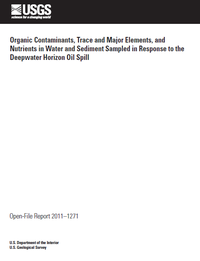Beach water and sediment samples were collected along the Gulf of Mexico coast to assess differences in contaminant concentrations before and after landfall of Macondo-1 well oil released into the Gulf of Mexico from the sinking of the British Petroleum Corporation's Deepwater Horizon drilling platform. Samples were collected at 70 coastal sites on the Gulf of Mexico between May 7 and July 7, 2010, to document baseline, "pre-landfall" conditions. A subset of these sites was resampled during October 4 to 14, 2010, after oil had made landfall on the Gulf of Mexico coast ("post-landfall") to determine if actionable concentrations of oil were present along shorelines.
Few organic contaminants were detected in water; their detection frequencies were generally low and similar in pre-landfall and post-landfall samples. Only one organic contaminant, toluene, had significantly higher concentrations in post-landfall than pre-landfall water samples. No samples exceeded any human-health benchmarks, and only one sample exceeded an aquatic-life benchmark-the toxic-unit benchmark for polycyclic aromatic hydrocarbons (PAH) mixtures was exceeded in one post-landfall water sample from Louisiana. No exceedance was observed in the corresponding pre-landfall water sample at this site.
In sediment, several PAHs were detected at over 20 percent of sites. Concentrations of 3 parent PAHs and 17 alkylated PAH groups were significantly higher in post-landfall samples than pre-landfall samples. One pre-landfall sample from Texas exceeded the sediment toxic-unit benchmark for PAH mixtures; this site was not sampled during the post-landfall period, so no comparison between sampling periods could be made. Twenty-seven percent of sediment samples exceeded empirical sediment-quality benchmarks (upper screening values) for PAHs, indicating these samples are in the probable-effect range. A higher percentage of post-landfall samples exceeded upper screening-value benchmarks (37 percent) than did pre-landfall samples (22 percent), but there was no significant difference in the proportion of samples exceeding one or more benchmarks between paired pre-landfall and post-landfall samples. Seven sites had the largest concentration differences between post-landfall and pre-landfall samples for fifteen alkylated PAHs. Five of these seven sites (1 site in Louisiana, 1 in Mississippi, and 3 in Alabama) were identified on the basis of diagnostic geochemical biomarkers as containing Macondo-1 oil in post-landfall sediments and tarballs, as described in a companion report by Rosenbauer and others (2010).
For trace and major elements in water, analytical reporting levels for several elements were highly variable; after censoring to a common reporting threshold, concentrations were significantly different between pre-landfall and post-landfall samples for a few elements, all of which are elements in seawater. No human-health benchmarks were exceeded, although these were available for only two elements. Aquatic-life benchmarks for trace elements were exceeded in almost 50 percent of water samples. Post-landfall samples exceeded one or more acute benchmarks in 21 percent, and chronic benchmarks in 93 percent of samples, compared to 1 percent (acute) and 39 percent (chronic) for pre-landfall samples. The elements responsible for the most exceedances in post-landfall samples were boron (48 samples), copper (22), and manganese (12). Nickel and vanadium, which U.S. Environmental Protection Agency specifically identified as relevant to the oil spill, were responsible for exceedances in only one of the fifty-two post-landfall samples with exceedances. These results represent the minimum number of exceedances for several trace elements because a substantial number of samples could not be compared with benchmarks because the element was determined during only one sampling period (boron and vanadium) or the reporting level for the sample was higher than the applicable benchmark value (for example, cobalt, copper, lead, and nickel). The high and variable reporting levels for trace elements in water also precluded the statistical comparison between sampling periods of the proportion of samples exceeding benchmarks.
For trace elements in whole (unsieved) sediment, 47 percent of samples exceeded empirical upper screening-value benchmarks, indicating these samples are in the probable-effect range. However, there was no significant difference in the proportion of samples exceeding one or more benchmarks between paired pre-landfall post-landfall samples. Benchmark exceedance frequencies could be conservatively high, because they are based on measurements of total trace-element concentrations, including the sediment matrix. In fine sediment (the less than 63-micrometer sediment fraction), one or more trace or major elements were anthropogenically enriched relative to national baseline values for U.S. streams for almost all sediment samples (123 of 124). Sixteen percent of sediment samples exceeded upper screening-value benchmarks for, and were enriched in, one or more of the element(s) barium (in 14 samples), vanadium (5), aluminum (3), manganese (3), arsenic (2), chromium (2), and cobalt (1). These samples, collected from Louisiana and Texas, were evenly divided between the pre-landfall (9 samples) and post-landfall (10 samples) periods.
Considering all the information evaluated in this report, there were significant differences between pre-landfall and post-landfall samples for PAH concentrations in sediment. Pre-landfall and post-landfall samples did not differ significantly in concentrations or benchmark exceedances for most organics in water or trace elements in sediment. For trace elements in water, aquatic-life benchmarks were exceeded in almost 50 percent of samples, but the high and variable analytical reporting levels precluded statistical comparison of benchmark exceedances between sampling periods. Concentrations of several PAH compounds in sediment were significantly higher in post-landfall samples than pre-landfall samples, and five of seven sites with the largest differences in PAH concentrations also had diagnostic geochemical evidence of Deepwater Horizon Macondo-1 oil from Rosenbauer and others (2010).


